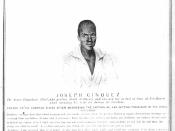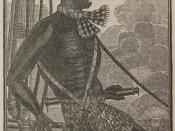Amistad: A Critical Interpretation
In 1839, slaves aboard the ship called Amistad revolted to win back their freedom at the same time sailing to one Cuban port from another. Their leader was Sengbe Pieh, better known as Joseph Cinque, who was a young Mende man. Most of the slaves had been captured from Seirra Leone and sold to Spanish slave traders. Eventually they won back their freedom in 1841, after two years of debating whether or not they should be returned to their homes in West Africa or remain so called "slaves" as Cuban property. The revolt had a great impact in the United States. It touched many hearts but at the same time embarrassed some. It changed the course of American History and bettered the lives of African American culture.
The hero of this story, Sengbe Pieh, was born in the year 1813 in the town of Mani located in Upper Mende country.
He was said to have been the son of a local chief. He was married and had a son and two daughters. Sengbe, who was a farmer, was captured while going to his field one day. He was taken to a nearby village where he stayed for three days. Sengbe was forced to Lomboko later on and sold to the richest slave keeper there.
More and more people came as imprisoned slaves. They were all shipped from Lomboko on the ship Tecora and taken to Havana in Cuba in June. Jose Ruiz, a Spanish plantation owner, bought Sengbe and forty-eight other slaves to work for his sugar plantation at Puerto Principe three hundred miles from Havana. Pedro Montes bought four children, heading for the same port. On June 26, the fifty- three Africans were shoved on the Spanish ship called La Amistad. They were whipped...


